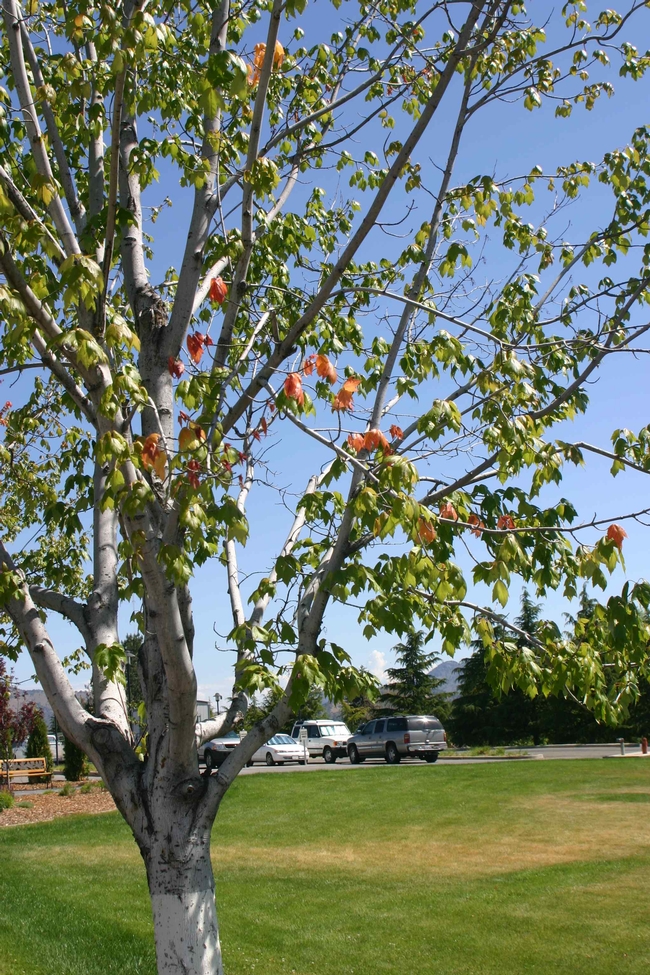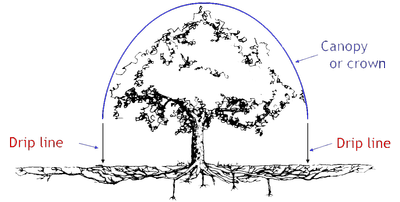- Author: Melissa G. Womack

Prioritizing Trees for Landscape Water Use
Many residents have been encouraged to reduce water use by turning off their outdoor watering systems, but this may be causing stress to established trees that are becoming increasingly thirsty for water.
In most traditional residential landscapes trees are surrounded by turfgrass. Turfgrass surrounded trees take advantage of the frequent and shallow watering schedule, typically set to help the lawn flourish. When residents eliminate or reduce water for lawns, trees cannot easily adapt to the new water shortage.
“Mature fruit trees and landscape trees are worth saving! Recognizing early signs of drought stress is important because irreversible damage can occur that no amount of watering will correct.” said Janet Hartin, UC Cooperative Extension advisor in a recent article, Save Water, But Also Save Trees During a Drought.
Replacing small plants, lawns and shrubs is easy compared to a large tree which takes years to become established. Saving mature trees during a drought should be a top priority in your landscape water use allocation.
“Two seasons without enough water can result in severe drought stress and even kill a tree,” warned Hartin. “Also, drought-stressed trees are more prone to damage from diseases and insects than non-stressed trees.”
Understanding how to water a tree effectively is important to avoid water waste and to ensure that the tree is receiving the correct amount of water for its survival.
One key factor to successfully watering a tree is understanding what soil type is present. Understanding soil types is an important factor in determining how much water is stored in the ground. For example, sandy soils dry out quickly while clay soils retain more water. Contact your local UC Master Gardener Program to learn how to determine your soil type.

Tree Ring Irrigation Contraption (TRIC)
Recently the Calif. Center for Urban Horticulture (CCUH) at UC Davis, UC Division of Agriculture and Natural Resources (ANR) and Ewing Irrigation devised a unique watering system called the Tree Ring Irrigation Contraption (TRIC). Using previous data from Netafim drip tube tables and from the Irrigation Association Landscape Irrigation Auditor manual, the partners envisioned a possible solution to mitigating drought conditions and the effect on landscape trees. The TRIC is an inexpensive kit that homeowners can put together for around $100 for one large tree.
The TRIC could enable homeowners to adequately water trees to a depth of three feet with confidence, by using the recommended parts and using the TRIC calculator with accurate information. Aside from a recommended parts list, there is a “plug-in” calculator created by Dr. Loren Oki, UC ANR Associate Specialist in Cooperative Extension Landscape Horticulture for UC Davis & UC ANR. The TRIC calculator helps determine the run-time needed for the device.
Learn more by visiting:




CHEERS
used almost same sources for an item at the Contra Costa MG newsletter...
CHEERS
The only way that I would agree that a soaker hose is okay to use is if there was a water meter used to only provide a specific volume of water through the soaker hose. That volume to apply would need to be calculated using some of the methods used to calculate the irrigation duration and length of the in-line drip tube in the TRIC spreadsheet.
Loren
Thanks.
This might also prevent you from using the total recommended length of tubing. Should this happen, reduce the calculated runtime proportionally: For an 18' diameter tree canopy, 2 lengths of drip tube are recommended. If you end up using only one length of tubing, then reduce the runtime by half. I just means that you will have to irrigate more frequently. Watch the tree for water stress symptoms. If small twigs and leaves start to wilt and don't recover the next morning, apply another irrigation right away.
Loren
You'll have to do the best you can to apply water to the tree roots. You'll have to make a guess as to where the roots are and lay the drip tube appropriately. Since the tree is only 4 feet from the street, hopefully there is a larger landscaped area on the other side of the tree. You can start laying the drip tube closer to the tree than the directions indicate, about 6 feet from the tree trunk, and progress outward to and past the drip line of the tree canopy.
This might also prevent you from using the total recommended length of tubing. Should this happen, reduce the calculated runtime proportionally: For an 18' diameter tree canopy, 2 lengths of drip tube are recommended. If you end up using only one length of tubing, then reduce the runtime by half. I just means that you will have to irrigate more frequently. Watch the tree for water stress symptoms. If small twigs and leaves start to wilt and don't recover the next morning, apply another irrigation right away.
Loren
Thanks again for taking time to address my problem.
Liz
Many thanks for a reply
Many thanks for a reply
TRIC and RSIC (http://ccuh.ucdavis.edu/public/drought/rotary-system-irrigation-contraption-rsic/RSIC) systems aren't for everyone but we want to make sure to present available options as we look to preserve our landscape trees during months with no/limited rain. The recommendations you are giving are another option for tree care. Here is a link to irrigation tips during drought: http://cagardenweb.ucanr.edu/Drought_/Drought_Irrigation_Tips_/. Check out the resources compiled under 'Irrigation Scheduling Worksheet'.
Thanks for everything you do!
Missy